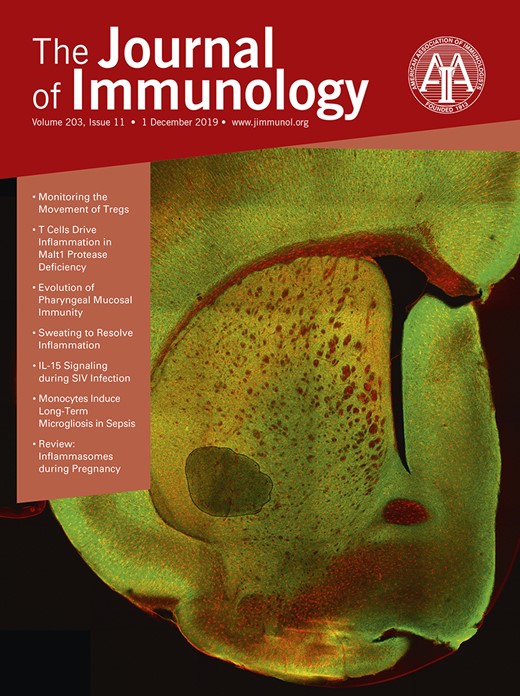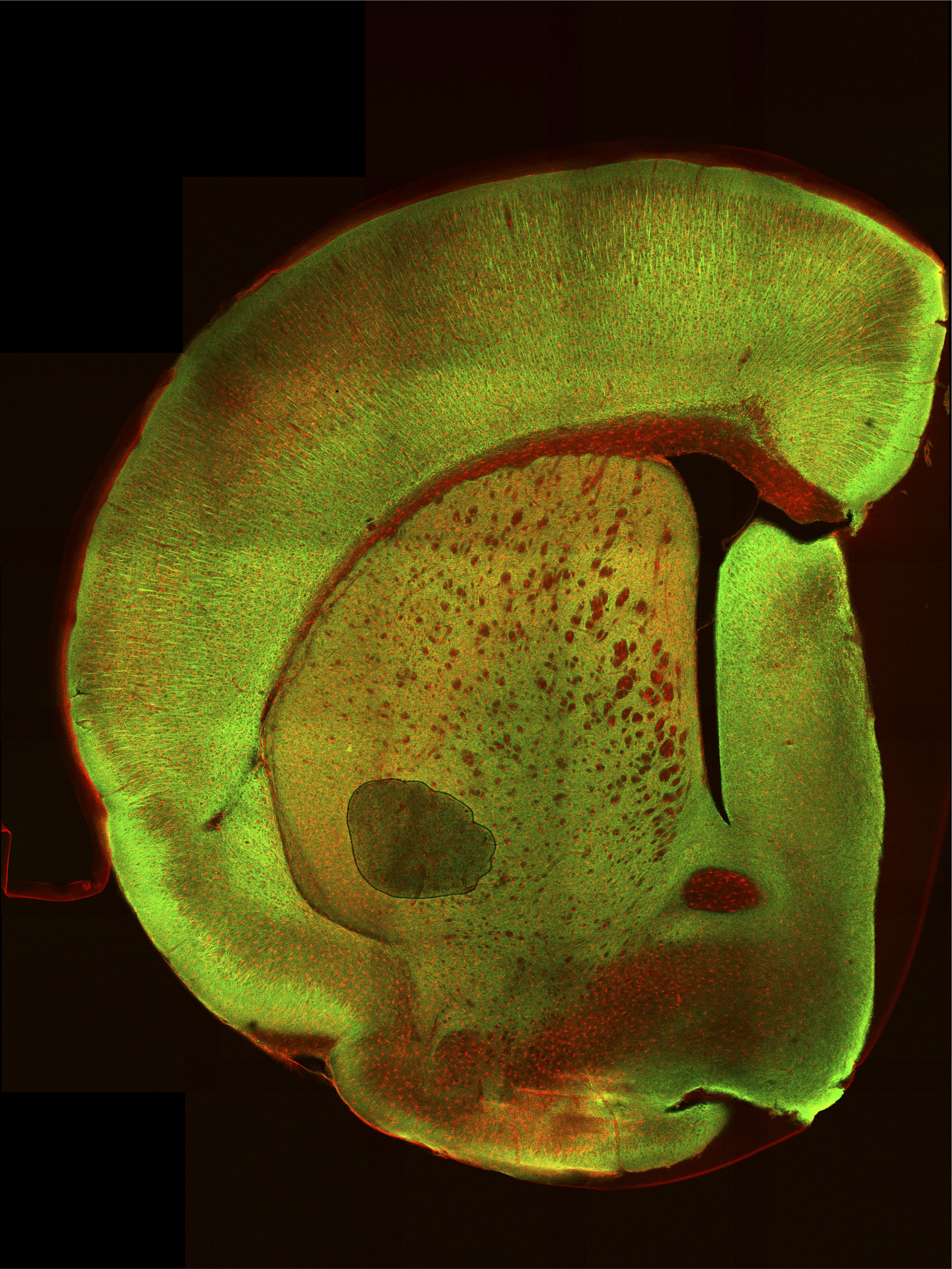
Cover image

On the cover: Tiled immunofluorescent image of a 100-μm coronal section of mouse brain right hemisphere after 24 h LPS-induced endotoxemia, a model of severe sepsis. Green represents microtubule-associated protein 2, a marker for healthy neuron dendrite outgrowths. Red represents Iba1, a marker specific for microglia, here upregulated in the septic brain. Trzeciak, A., Y. V. Lerman, T.-H. Kim, M. R. Kim, N. Mai, M. W. Halterman, and M. Kim. 2019. Long-term microgliosis driven by acute systemic inflammation. J. Immunol. 203: 2979–2989.
Volume 203, Issue 11, December 2019
Top Reads
Top Reads
Translating Immunology
Low-Dose IL-2 Therapy in Transplantation, Autoimmunity, and Inflammatory Diseases
Brief Reviews
Inflammasomes: Their Role in Normal and Complicated Pregnancies
Cutting Edge
Cutting Edge: TCR Signal Strength Regulates Acetyl-CoA Metabolism via AKT
TCR signal strength regulates acetyl-CoA metabolism.
Weak TCR signals promote phosphorylation of citrate synthase via Akt.
TCR signal strength differentially regulates acetyl-lysine containing proteins.
Allergy and other Hypersensitivities
Inhibition of Allergic Reactivity through Targeting FcεRI-Bound IgE with Humanized Low-Affinity Antibodies
LARI inhibits allergic reactivity while displaying an excellent safety profile.
LARI blunts allergic responses via multiple mechanisms at multiple steps.
Autoimmunity
Malt1 Protease Deficiency in Mice Disrupts Immune Homeostasis at Environmental Barriers and Drives Systemic T Cell–Mediated Autoimmunity
Autoreactive T cells drive the lethal disease in Malt1PD mice.
Malt1PD mice display B cell hyperactivation to environmental Ags.
IPEX-like disease occurs in Malt1PD mice despite in vitro Treg suppressive activity.
cAMP Response Element Modulator α Induces Dual Specificity Protein Phosphatase 4 to Promote Effector T Cells in Juvenile-Onset Lupus
CREMα induces DUSP4 phosphatase expression in CD4+ T cells.
DUSP4 promotes IL-17A and reduces IL-2 production by effector T cells.
The CREMα/DUSP4 axis is involved in the pathophysiology of SLE.
Functional Characterization of CD11c+ Age-Associated B Cells as Memory B Cells
CD11c+ ABCs exhibit functional characteristics of MBCs.
ABCs express polyreactive B cell receptors binding diverse self-antigens.
Adoptively transferred ABCs contribute to rapid recall responses to viral Ags.
UBASH3A Regulates the Synthesis and Dynamics of TCR–CD3 Complexes
UBASH3A interacts with the TCR–CD3 complex and regulates its turnover.
UBASH3A facilitates the downmodulation of cell-surface TCR–CD3 upon TCR engagement.
UBASH3A binds to CBL-B, another T1D-associated protein that inhibits T cell function.
TNF-Induced Interstitial Lung Disease in a Murine Arthritis Model: Accumulation of Activated Monocytes, Conventional Dendritic Cells, and CD21+/CD23− B Cell Follicles Is Prevented with Anti-TNF Therapy
TNF-Tg mice develop NSIP-like lung disease with increased cDC2 and macrophages.
Anti-TNF therapy modulates prefibrotic ILD in TNF-Tg mice.
Immune Regulation
Regulatory T Cell Transmigration and Intravascular Migration Undergo Mechanistically Distinct Regulation at Different Phases of the Inflammatory Response
Regulatory T cells can undergo extensive intravascular crawling in skin vessels.
Mechanisms of regulatory T cell transmigration can be modulated dynamically.
RELMα Licenses Macrophages for Damage-Associated Molecular Pattern Activation to Instigate Pulmonary Vascular Remodeling
RELMα (hResistin) activates pulmonary macrophages in PAH patients and hypoxic mice.
RELMα (hResistin) induces HMGB1 acetylation by suppressing Sirt1 in macrophages.
The RELMα–HMGB1 axis causes macrophage-mediated PASMC proliferation.
TLR2 Stimulation Increases Cellular Metabolism in CD8+ T Cells and Thereby Enhances CD8+ T Cell Activation, Function, and Antiviral Activity
TLR2 directly regulates the anti-CD3–activated CD8+ T cells independently on APCs.
Bioenergy metabolism is important for TLR2-mediated enhancement of CD8+ T cells.
TLR2 enhances the antiviral CD8+ T cell response and the efficacy of HBV vaccine.
Downregulation of MHC Class II by Ubiquitination Is Required for the Migration of CD206+ Dendritic Cells to Skin-Draining Lymph Nodes
MHCII molecule upregulation is not required for the development of skin moDCs.
Skin CD206+ moDCs do not migrate to LNs in the absence of MHCII ubiquitination.
GM-CSF restores the migration of skin moDCs by upregulating CCR7 and IRF4.
Immune System Development
Folliculin Interacting Protein 1 Maintains Metabolic Homeostasis during B Cell Development by Modulating AMPK, mTORC1, and TFE3
Fnip1 is required for pre–B cell development/survival independent of p53 and Bcl-xL.
Fnip1 is required for optimal inhibition of mTORC1 in response to amino acid restriction.
Fnip1 regulates TFE3 nuclear translocation and lysosome biogenesis in pre–B cells.
Immunogenetics
Ancient BCMA-like Genes Herald B Cell Regulation in Lampreys
Two lamprey BCMA-like receptors interact with a single lamprey BAFF protein.
BCMAL1 and BCMAL2 genes are differentially expressed during VLRB cell stimulation.
BAFF-based mechanisms for B cell regulation appeared early in vertebrate evolution.
Immunotherapy and Vaccines
MR1-Independent Activation of Human Mucosal-Associated Invariant T Cells by Mycobacteria
MAIT cells comprise half the CD8 T cell IFN-γ response to BCG in blood.
Frequencies of MAIT cells were not sustainably modulated by BCG vaccination.
Innate cytokines mediate BCG-induced MAIT cell responses in whole blood.
Infectious Disease and Host Response
Role of IL-15 Signaling in the Pathogenesis of Simian Immunodeficiency Virus Infection in Rhesus Macaques
Anti–IL-15 depletes NK cells and disrupts TEM homeostasis in SIV-infected RM.
IL-15 inhibition does not alter SIV replication dynamics or CD4+ T cell depletion.
IL-15 inhibition does accelerate reactivation of an oncogenic γ-herpesvirus.
The IL-12– and IL-23–Dependent NK Cell Response Is Essential for Protective Immunity against Secondary Toxoplasma gondii Infection
NK cells are required for immune control of secondary T. gondii infection.
NK cells do not develop intrinsic memory-like features during T. gondii infection.
Secondary NK cell responses depend upon IL-12 and IL-23.
Multiple Signaling Pathways Involved in Human Dendritic Cell Maturation Are Affected by the Fungal Quorum-Sensing Molecule Farnesol
FOH promotes CD1d expression in human DC via activation of PPARγ, RARα, and p38 MAPK.
FOH modulates cytokine release through nuclear receptors, MAPK, and NF-κB pathways.
FOH diminishes human DC capacity to activate iNKT, Th1, and FOXP3+ regulatory T cells.
Innate Immunity and Inflammation
The TL1A-DR3 Axis Selectively Drives Effector Functions in Human MAIT Cells
DR3 is highly expressed on human MAIT cells.
DR3 ligand TL1A licenses innate TNF-α production and boosts polyfunctionality.
TL1A equally augments TCR-dependent MAIT cell effector functions.
Long-Term Microgliosis Driven by Acute Systemic Inflammation
Early monocyte infiltration causes long-term microgliosis in sepsis.
Brain microglia self-proliferate during severe sepsis.
Microglia proliferation is associated with local M-CSF.
Glycogen Synthase Kinase 3β Regulates Antiviral Responses of TLR3 via TRAF2–Src Axis
GSK3β interacts with Src tyrosine kinase.
Src positively regulates antiviral immune response.
Src undergoes K63-linked ubiquitination by TRAF2.
A Dynamic Variation of Pulmonary ACE2 Is Required to Modulate Neutrophilic Inflammation in Response to Pseudomonas aeruginosa Lung Infection in Mice
Pseudomonas bacterial lung infection leads to pulmonary ACE2 dynamic variation.
The ACE2 dynamic alteration is critical in regulating neutrophilic lung inflammation.
ACE2 modulates IL-17–mediated neutrophil influx by impacting STAT3 activity.
Exercise Promotes Resolution of Acute Inflammation by Catecholamine-Mediated Stimulation of Resolvin D1 Biosynthesis
Exercise enhances resolution of acute inflammation and RvD1 biosynthesis.
Epinephrine stimulates macrophage production of RvD1 through α1-AR.
α1-AR blockade in vivo abrogates exercise-enhanced resolution.
Molecular and Structural Immunology
Ubc9 Interacts with and SUMOylates the TCR Adaptor SLP-76 for NFAT Transcription in T Cells
Ubc9 interacts with and SUMOylates the immune adaptor SLP-76 in T cells.
Synergy of SLP-76–Ubc9 on IL-2 transcription is SLP-76 SUMOylation dependent.
SLP-76 SUMOylation is required for Ubc9-NFAT complex assembly for IL-2 transcription.
Recognition of Lewis X by Anti-Lex Monoclonal Antibody 1G5F6
Recognition of monomeric Lex by 1G5F6 using a panel of Lex analogues was studied.
Anti-Lex mAbs bind in different ways; the hydrophobic patch of β-d-Gal is essential.
Mucosal Immunology
Uhrf1-Mediated Tnf-α Gene Methylation Controls Proinflammatory Macrophages in Experimental Colitis Resembling Inflammatory Bowel Disease
Uhrf1-mediated DNA methylation represses Tnf-α expression in macrophages.
Uhrf1 deficiency augments Tnf-α expression, resulting in aggravated colitis.
Tnf-α triggers macrophage activation through destabilizing Uhrf1 protein.
Pharyngeal Immunity in Early Vertebrates Provides Functional and Evolutionary Insight into Mucosal Homeostasis
A mucosally associated lymphoid tissue is identified in teleost pharyngeal cavity.
Trout pharyngeal bacteria are mainly coated with secretory IgT.
Teleost IgT plays a vital role in protecting the PC from invading pathogens.
Dendritic Cells Control Regulatory T Cell Function Required for Maintenance of Intestinal Tissue Homeostasis
Inhibitory receptors are upregulated on peripheral Tregs of DC-deficient mice.
Tregs from DC-deficient mice are functionally impaired.
Tregs require DCs for inhibition of T cell transfer-induced colitis.
Tumor Immunology
STAT3-Induced Wnt5a Provides Chronic Lymphocytic Leukemia Cells with Survival Advantage
STAT3 induces the expression of Wnt5a in CLL cells.
Wnt5a provides CLL cells with survival advantage.


